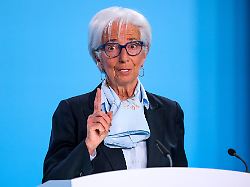End of the high interest rate phase
ECB agrees to cut interest rates – June data crucial
April 11, 2024, 7:00 p.m
Listen to article
This audio version was artificially generated. More info | Send feedback
As expected, the ECB is once again not touching interest rates – but a change of course is tangible. After a flood of data in June, this will probably be the case. Experts expect that this will be the start of several interest rate hikes.
In view of the reduced inflation, the euro currency watchdog is preparing consumers and companies for the first interest rate cut since summer 2022. Inflation has continued to decline and most measures of underlying inflation have also eased, said ECB President Christine Lagarde in Frankfurt following a council meeting. “In June we will have a lot more data and new projections.” Then the council will decide whether its expectations have been fulfilled.
Some members of the Monetary Policy Council were already confident that the conditions for a reduction had been met, said Lagarde. However, they were prepared to join the large majority in the Council, which preferred to wait for additional information in June. Then the ECB experts present the new inflation and economic forecasts.
Andreas Bley, chief economist at the Federal Association of German Volksbanks and Raiffeisenbanks (BVR), expects that “only a turnaround in the upcoming economic figures with a contrary-to-expected wage increase or an upward jump in inflation” could delay an interest rate cut. According to VP Bank chief economist Thomas Gitzel, further easing is likely to follow if interest rates are cut in June. “Just a reduction in interest rates makes little economic sense.”
Meanwhile, the central bank left interest rates unchanged for the fifth time in a row. The interest rate at which banks can obtain fresh money from the central bank remains at 4.5 percent. The deposit interest that banks receive for parked funds remains unchanged at 4.0 percent in the common currency area of the 20 member states.
Inflation in the euro area recently weakened more than expected. In March, consumer prices rose by 2.4 percent over the year, according to an initial estimate. Inflation was 2.6 percent in February and 2.8 percent in January. In March 2023, inflation was still 6.9 percent.
The price development is thus approaching the ECB’s goal of an annual inflation rate of two percent in the medium term. At this value, the monetary authorities see price stability guaranteed. The central bank currently expects the target value to be reached by mid-2025. “There will be bumps along the way, it won’t be linear,” Lagarde said.
Another argument in favor of interest rate cuts in the euro area is that the prospects for the economy in the euro area have deteriorated. The ECB recently expected only 0.6 percent growth this year. In December, 0.8 percent was predicted.
